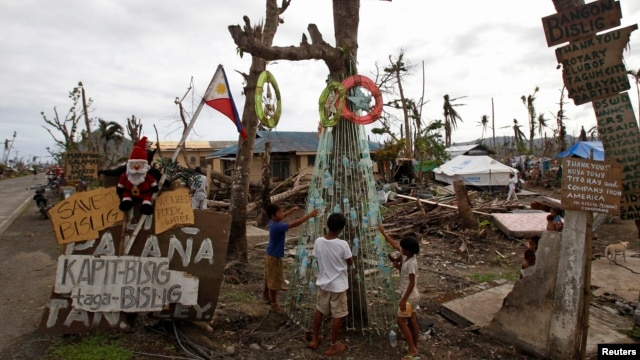
Children, victims of super typhoon Haiyan, decorate their improvised Christmas tree with empty cans and bottles at the ravaged town of Tanuan, Leyte province, central Philippines, Dec. 19, 2013.
PALO, PHILIPPINES — Philippine mother Rhodora Tonningsen has no tinsel or ornaments for her Christmas tree this year, so she's decorated it with packets of instant noodles and empty sardine cans from relief supplies handed out to survivors of Typhoon Haiyan.
Across the center of the mostly Catholic Philippines, people are scraping together whatever they can to celebrate Christmas, nearly seven weeks after the storm. Some are struggling to cope with their grief.
Tonningsen, 43, a single mother of four, pried a battered, three-foot artificial Christmas tree from the bank of mud and debris thrown up by the storm by her tiny, partly damaged home in the town of Palo, and put it up on the front porch.
“I just washed it so we'll have some semblance of Christmas, even if we're in dire straits,” said Tonningsen, standing outside her home, now patched with corrugated iron also salvaged from the debris.
“We may be in ground zero, but it's OK - as long as we are alive and our family is intact,” she continued.
The Nov. 8 storm was one of the strongest ever to hit land. It wiped out virtually everything in its path, killing more than 6,100 people. Another 1,800 are listed as missing.
More than four million people are homeless, celebrating Christmas in tents, evacuation centers, or in the ruins of their houses.
Peter Lacandazo, 56, is for the first time spending Christmas without most of his family. Twenty-two relatives, including his wife, five daughters, sons-in-law, and grandchildren, drowned when the storm surge crashed ashore.
“I said to myself earlier in church that I should have died along with them,” Lacandazo said as he stood outside a tent in what used to be the garage of his family compound.
Lacandazo, his son and a grandson, the only family he has left, will hear midnight Mass on Christmas Eve and leave some food on a grave where his family is buried.
“They are together, they are many. So they won't be sad, unlike us,” Lacandazo said.
About 90 percent of the Philippines' 97 million people are Christian, most Roman Catholics.
Palo town is in Leyte, an island province which suffered the highest death toll. Businesses are still largely shuttered, power has yet to be fully restored, and security is fragile in some areas where carpetbaggers and thieves roam, residents say.
Many survivors find strength in church.
“Faith, we're keeping the faith,” said Ronald Lago, 47, after a dawn Mass with his family. “We are together and that's all that matters,” he said as a Philippine Christmas carol played out over the church's speakers.
|
|
